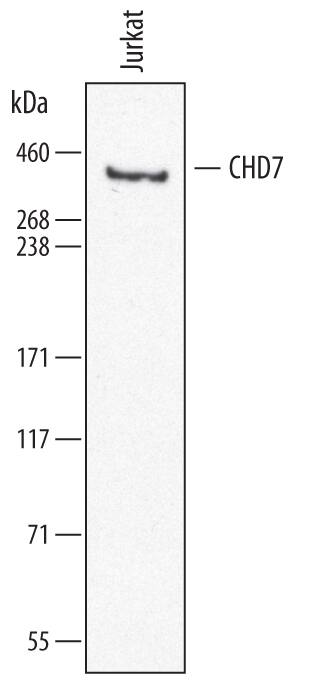Human CHD7 Antibody
R&D Systems, part of Bio-Techne | Catalog # AF7350

Key Product Details
Species Reactivity
Validated:
Cited:
Applications
Validated:
Cited:
Label
Antibody Source
Product Specifications
Immunogen
Ala263-Gln457
Accession # Q9P2D1
Specificity
Clonality
Host
Isotype
Scientific Data Images for Human CHD7 Antibody
Detection of Human CHD7 by Western Blot.
Western blot shows lysates of Jurkat human acute T cell leukemia cell line. PVDF membrane was probed with 0.5 µg/mL of Sheep Anti-Human CHD7 Antigen Affinity-purified Polyclonal Antibody (Catalog # AF7350) followed by HRP-conjugated Anti-Sheep IgG Secondary Antibody (Catalog # HAF016). A specific band was detected for CHD7 at approximately 350 kDa (as indicated). This experiment was conducted under reducing conditions and using Immunoblot Buffer Group 8.CHD7 in HepG2 Human Cell Line.
CHD7 was detected in immersion fixed HepG2 human hepatocellular carcinoma cell line using Sheep Anti-Human CHD7 Antigen Affinity-purified Polyclonal Antibody (Catalog # AF7350) at 10 µg/mL for 3 hours at room temperature. Cells were stained using the NorthernLights™ 557-conjugated Anti-Sheep IgG Secondary Antibody (red, upper panel; Catalog # NL010) and counterstained with DAPI (blue, lower panel). Specific staining was localized to nuclei. View our protocol for Fluorescent ICC Staining of Cells on Coverslips.Applications for Human CHD7 Antibody
Immunocytochemistry
Sample: Immersion fixed HepG2 human hepatocellular carcinoma cell line
Western Blot
Sample: Jurkat human acute T cell leukemia cell line
Formulation, Preparation, and Storage
Purification
Reconstitution
Formulation
Shipping
Stability & Storage
- 12 months from date of receipt, -20 to -70 °C as supplied.
- 1 month, 2 to 8 °C under sterile conditions after reconstitution.
- 6 months, -20 to -70 °C under sterile conditions after reconstitution.
Background: CHD7
CHD7 (Chromohelicase/ATPase DNA-binding protein 7) is a 350 kDa member of the third subgroup in the SNF2/RAD54 helicase family of proteins. It is an ATP‑dependent chromatin remodeling factor that also binds histones (H3 at Lys4) and influences transcription. CHD7 binds more that 10,000 sites on chromatin, particularly in locations associated with gene enhancement. Notably, CHD7 is most associated with the nervous system, and is found in embryonic hypothalamus (GnRH neurons), olfactory epithelium and spinal cord, and adult preoptic hypothalamus plus hippocampus. Human CHD7 is 2997 amino acids (aa) in length. It contains consecutive Gln-, Pro- and Lys-rich regions (aa 151-718), two Chromo (chromatin-organizer-modifer) domains (aa 800-947), a helicase ATP-binding domain (aa 980-1154), a C-terminal helicase domain (aa 1294-1464), one coiled-coil region (aa 2410-2431) and two BRK domains (aa 2562-2604 and 2642-2686). There are at least seven utilized Ser/Thr phosphorylation sites, and three potential isoform variants. One isoform contains a 12 aa substitution for aa 1127-2997, a second 145 kDa isoform shows a deletion of aa 573-2621, while a third isoform contains a 15 aa insertion after Ser698. CHD7 is reported to bind to subgroup three member CHD8. Over aa 263-457, human CHD7 shares 96% aa identity with mouse CHD7.
Long Name
Alternate Names
Gene Symbol
UniProt
Additional CHD7 Products
Product Documents for Human CHD7 Antibody
Product Specific Notices for Human CHD7 Antibody
For research use only

